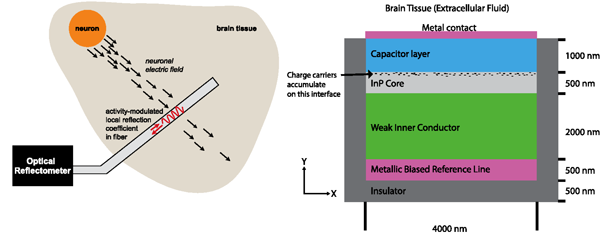Recording the Brain with Light: Hertz Fellows Pursue Novel Approach to Neural Mapping
The human brain is one of life’s greatest mysteries. It contains about 100 billion neurons, each one emitting electrical signals almost a million times smaller than those from microchips.
To adequately understand how the brain works requires widespread mapping of neural activity, posing an immense challenge to neuroscience. As of yet, no one has come up with a technology able to record such a large amount of information simultaneously, and to do so in a minimally invasive way.
However, a team of researchers, led by Hertz Fellows and MIT Media Lab members Sam Rodriques and Adam Marblestone, think they may have discovered a solution–using light to detect neural activity through optical fibers threaded deep into the brain.
“The main question is how do you transduce the electrical activity of the neurons into an optical signal? This is something that people do all the time (in the telecommunications industry),” said Rodriques, a second year grad student. “Once we realized they were two different regimes of the same technology it was pretty straightforward… It’s possible to multiplex signals into an optical fiber that you simply can’t in an electrical channel.”
With the assistance of several other Fellows, Rodriques and Marblestone outlined their design for the fiber-optic based system in a paper published in April by the Journal of Biomedical Optics, titled Multiplexed Neural Recording along a Single Optical Fiber Via Optical Reflectometry. Other Hertz Fellows involved in the study included Modern Electron co-founder Max Mankin, MIT Media Lab associate professor Ed Boyden, and Gates Foundation advisor and Hertz Director Emeritus Lowell Wood.
In the paper, the team describes a design to record neural activity along the length of an optical fiber, just one-tenth the thickness of a human hair. When a neuron fires, an adjacent portion of the fiber would become more reflective to passing light. An optical reflectometer device located outside the brain would detect and record the times and magnitudes of reflections as they come back, determining the neural activity along the fiber.
“The light can contain a huge amount of information, much more than you can encode in electricity,” Marblestone said. “We’re trying to get as much information from as small of a channel as possible.”
The advantages of using light, according to Marblestone and Rodriques, is that it would be much less invasive than other methods. One very thin optical wire could take the place of hundreds or thousands of electrical wires, that could then be threaded into the vasculature of the brain without doing permanent damage to the organ.
“We don’t have the ability at the moment to do neuroscience in humans,” Rodriques said. “The reason is that you just can’t insert electrodes into the brain for research. It’s really a fundamental challenge because you can do all the experiments you want with animal models, but the animals can’t tell you what they’re experiencing. If this (optical fiber) method becomes widespread, it will overcome that challenge. It has the potential to be transformative.”
The work builds off a paper published in 2013, authored by Marblestone and a group including Hertz Fellows Mikhail Shapiro, Dario Amodei and Ed Boyden. The paper titled, Physical Principles for Scalable Neural Recording, looked at a variety of possible ways scientists could record neural activity fast enough, at a high enough resolution, to create a real-time movie.
Gates Foundation advisor and Hertz Director Emeritus Lowell Wood read the paper and came up with a suggestion. Because there was no way to record all the activity in the brain using electronic wires, he insisted, the only way would be to use optical fibers threaded through all the blood vessels in the brain.
“Sam and I basically tried to figure out if this was actually true,” Marblestone said. “It sounds good, but can you actually measure neural activity with these fibers? Is there a way you can design the optical fiber to be sensitive to the turning on and off of the neuron? We’ve come up with a general class of design that we think might work for this problem.”
While Rodriques and Marblestone are confident the design could work in principle, they stress it’s still only a preliminary concept at the present time, and that improved designs should be possible. The idea has already attracted some interest from potential collaborators to do early stage fabrication and testing. The next step, they say, is to discuss the concept with experts who can critique the design and come up with improvements.
“The strategy here is that we’re trying to motivate people in photonics who have lots of experience dealing with sending information through optical fibers to realize that this is actually a problem they can work on,” Rodriques said. “There are methods out there that aren’t crazy; they’re possible.
